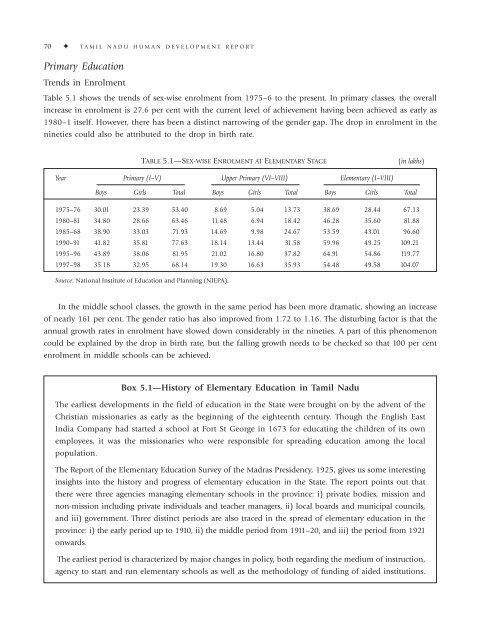Tamil Nadu 2003 - of Planning Commission
Tamil Nadu 2003 - of Planning Commission
Tamil Nadu 2003 - of Planning Commission
Create successful ePaper yourself
Turn your PDF publications into a flip-book with our unique Google optimized e-Paper software.
70 ✦ T AMIL NADU HUMAN DEVELOPMENT REPORT<br />
Primary Education<br />
Trends in Enrolment<br />
Table 5.1 shows the trends <strong>of</strong> sex-wise enrolment from 1975–6 to the present. In primary classes, the overall<br />
increase in enrolment is 27.6 per cent with the current level <strong>of</strong> achievement having been achieved as early as<br />
1980–1 itself. However, there has been a distinct narrowing <strong>of</strong> the gender gap. The drop in enrolment in the<br />
nineties could also be attributed to the drop in birth rate.<br />
TABLE 5.1—SEX-WISE ENROLMENT AT ELEMENTARY STAGE<br />
(in lakhs)<br />
Year Primary (I–V) Upper Primary (VI–VIII) Elementary (I–VIII)<br />
Boys Girls Total Boys Girls Total Boys Girls Total<br />
1975–76 30.01 23.39 53.40 8.69 5.04 13.73 38.69 28.44 67.13<br />
1980–81 34.80 28.66 63.46 11.48 6.94 18.42 46.28 35.60 81.88<br />
1985–68 38.90 33.03 71.93 14.69 9.98 24.67 53.59 43.01 96.60<br />
1990–91 41.82 35.81 77.63 18.14 13.44 31.58 59.96 49.25 109.21<br />
1995–96 43.89 38.06 81.95 21.02 16.80 37.82 64.91 54.86 119.77<br />
1997–98 35.18 32.95 68.14 19.30 16.63 35.93 54.48 49.58 104.07<br />
Source: National Institute <strong>of</strong> Education and <strong>Planning</strong> (NIEPA).<br />
In the middle school classes, the growth in the same period has been more dramatic, showing an increase<br />
<strong>of</strong> nearly 161 per cent. The gender ratio has also improved from 1.72 to 1.16. The disturbing factor is that the<br />
annual growth rates in enrolment have slowed down considerably in the nineties. A part <strong>of</strong> this phenomenon<br />
could be explained by the drop in birth rate, but the falling growth needs to be checked so that 100 per cent<br />
enrolment in middle schools can be achieved.<br />
Box 5.1—History <strong>of</strong> Elementary Education in <strong>Tamil</strong> <strong>Nadu</strong><br />
The earliest developments in the field <strong>of</strong> education in the State were brought on by the advent <strong>of</strong> the<br />
Christian missionaries as early as the beginning <strong>of</strong> the eighteenth century. Though the English East<br />
India Company had started a school at Fort St George in 1673 for educating the children <strong>of</strong> its own<br />
employees, it was the missionaries who were responsible for spreading education among the local<br />
population.<br />
The Report <strong>of</strong> the Elementary Education Survey <strong>of</strong> the Madras Presidency, 1925, gives us some interesting<br />
insights into the history and progress <strong>of</strong> elementary education in the State. The report points out that<br />
there were three agencies managing elementary schools in the province: i) private bodies, mission and<br />
non-mission including private individuals and teacher managers, ii) local boards and municipal councils,<br />
and iii) government. Three distinct periods are also traced in the spread <strong>of</strong> elementary education in the<br />
province: i) the early period up to 1910, ii) the middle period from 1911–20, and iii) the period from 1921<br />
onwards.<br />
The earliest period is characterized by major changes in policy, both regarding the medium <strong>of</strong> instruction,<br />
agency to start and run elementary schools as well as the methodology <strong>of</strong> funding <strong>of</strong> aided institutions.

















